After a wait of only about five and a half years, I finally got in my first game of Sam Mustafa's Might and Reason. I first acquired the game years ago, while still living in St. John's. In fact, the last geek thing I did before leaving was pick up a large French army from Stu of the John Street Gamers. Life, in the form of a divorce and several moves, got in the way of completing the project. While I sold off the figures, I kept the rules, and when I heard that some of the other guys at the THMG were interested, I more or less squealed like a little girl with her first kitten. I'd waited a long time to play this game, and found it worth the wait.
We played a somewhat simplified version of the army builder / pick-up rules, my partially completed French (with Nick the Lemming's Austrians standing in for some of my unpainted units) vs. Marke's British and Hanoverians. The mechanics of the M&R army builder link commander quality to size of army; the better your general, the fewer the troops. I had initially planned to build an army around a "great" general, the best available, and bought accordingly, but when I sat down to actually cook up a list for the game, I realized that in the SYW, the French are limited to Average commanders at best. This meant my army expanded by almost a third. Looks like Peter Berry at Baccuss 6mm will be getting another order from me.
Nick the Lemming and I got to the Dueling Grounds early. Rather than using the terrain mechanics of the game (which require a rather elegant interaction between sides), we went with the traditional "hey, that looks good" approach to terrain placement. Nick had brought along his collection of 6mm buildings, and we set up the board to show them off.
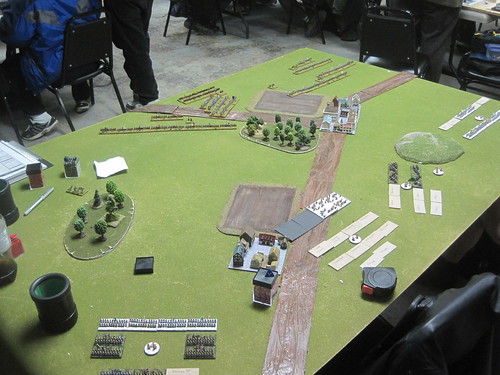
Two small towns, a couple of roads, some woods and a hill later, we were ready to go. Marke arrived, and we quickly rolled for our sub-commanders. Armies in M&R must be divided into "Forces", each of which is led by a sub-commander. The personality of these commanders is determined randomly, within a range defined by nationality and type. French command tends to be iffy, and I ended up with a range between +1 and -2. None of my sub-commanders were exceptional (i.e., might have a degree of independent initiative), and none were valorous (i.e., might be willing to risk their precious skins to encourage their men in assaults). Of course, my best command (consisting of grenadiers and vieux regiments) was led by my worst commander.
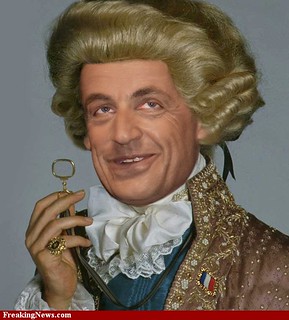
This guy.
Given that Marke had no light cavalry, I ended up with "total advantage" in determining terrain and deployment, and he deployed first. I followed, putting down my troops in what I'm officially designating the Worst Deployment Ever.
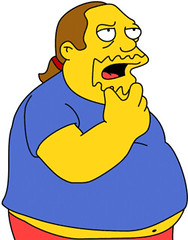
Even he agrees.
See the town in the middle of the board? Marke and I agreed that, since it was our first game, we'd treat the town as difficult ground, rather than using the town rules (which add a degree of complexity). See the forest, right beside the town? Also difficult ground. I deployed both my cavalry commands in the centre, right in front of the forest and town. Cavalry can't move in difficult ground.
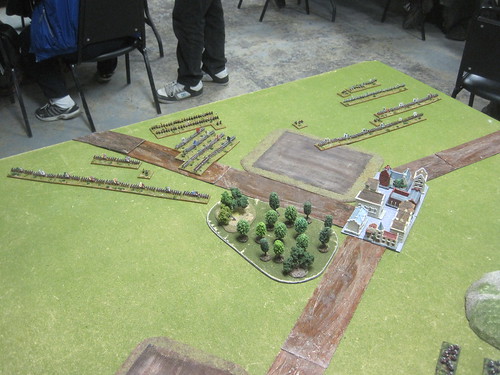
Maurice de Saxe is weeping in his grave.
One thing about the game I noticed quite early. Troop management is a headache. The linear formations required for combat are unwieldy, and units can't move through infantry deployed in fighting formation. Lesson 1 from the game was that smaller Forces are better. My forces had 6 or more units in them, and it was just too hard to coordinate. The next list I cook will have more subordinates, and smaller forces able to support each other, rather than trying to have units supporting each other in the same force.
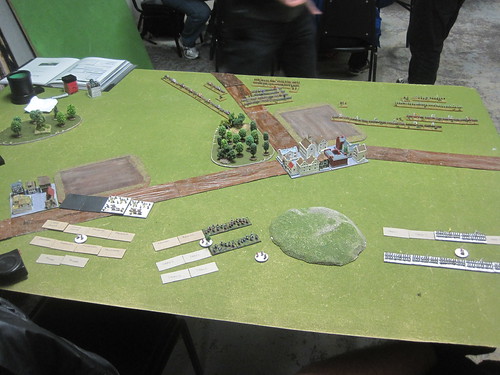
In the picture above, you can see the bulk of our deployment. I had my artillery massed in the centre, covering the field to the left of the larger village. One unit of cavalry was deployed behind the guns, another to their right. On my far right, I had my "strong" infantry force, and out of sight on my left, I had a second force.
In M&R, each turn is divided into a random number of pulses. There's a nice little mechanic that can provide for as many as 4 pulses in a turn, but there's no way to know how many there will be (the mechanic tends to front load - one or two is more likely than three or four). At the start of any given pulse, players roll for initiative, and find out at that point whether the pulse to be played will be the last. Command dice, which are the primary "resource management" dynamic of the game, last for the entire turn, so one is constantly having to debate whether to use one's dice (for fear of losing them) or to save them in case they become important in a later pulse. I encountered both situations in this game.

After resolving musketry and artillery, the active player rolls for his sub-commanders. Command dice can be assigned to give greater control over the outcome. That Force I mentioned, the on on my left? First turn, they rolled a 10 on the dice. Their commander had a +1 personality. That translated into an "attack" result, which meant the entire force deployed into fighting formation, and the units already in FF moved toward the enemy as rapidly as possible. This meant that the formation furthest from the enemy moved into the formation which allows for slowest movement. They didn't make contact until the turn we packed up the game. Command "friction" is very much a part of M&R, and I suspect learning how to manage it is one of the core skills for in-game success.
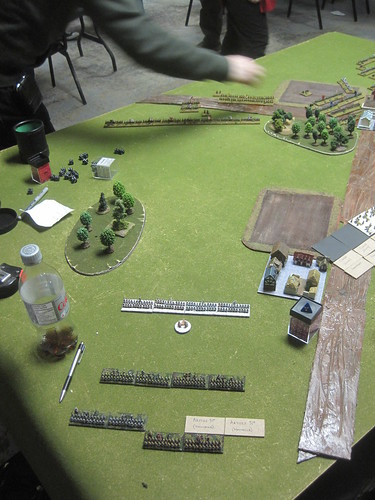
On right, Marke moved some of his infantry towards the town, while I jostled my cavalry about in an effort to make use of them. This would eventually produce something of a stand-off.
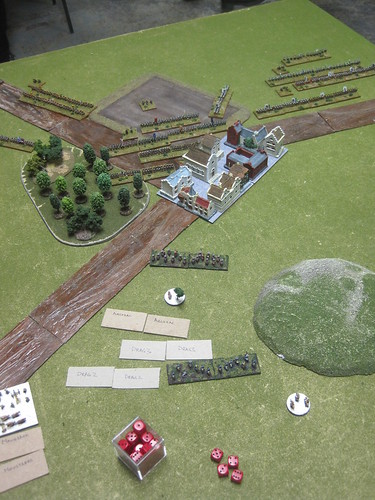
Between Marke's inability to get the infantry commander to do anything, and his reluctance to potentially expose his flanks to my cavalry, the two formations spent much of the game staring at each other.
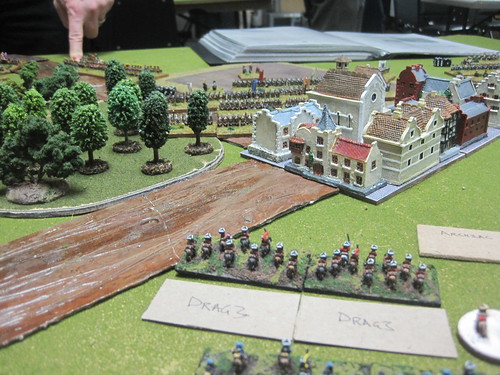
In the centre, Marke seemed reluctant to advance. I suspect it had to do with the four batteries of heavy artillery staring at him.
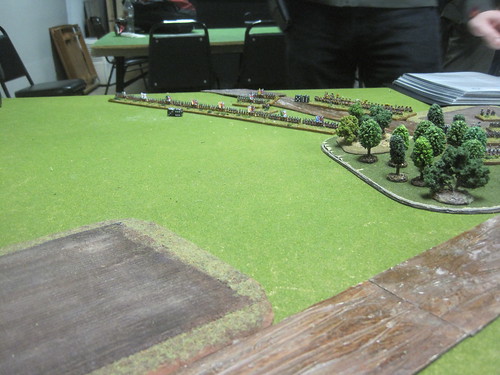
His troops did look pretty all lined up however.
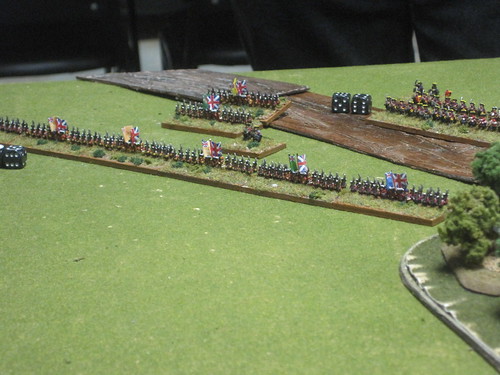
There was a bit of excitement when I threw my elite "La Reine" cavalry at his grenadiers, just to try out the combat mechanics.
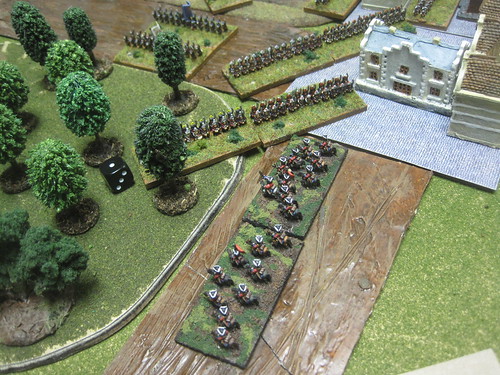
This had fairly predictable results, and the poor horsies ended up as dog food.
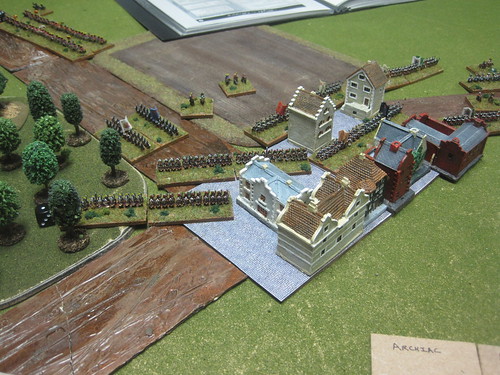
Realizing that Marke wasn't going to do me the courtesy of advancing into my guns, I slowly pushed my left / centre forward, but it was a slog. Marke's reluctance / inability to advance, combined with my shoddy deployment, meant that most of the action happened on my right.
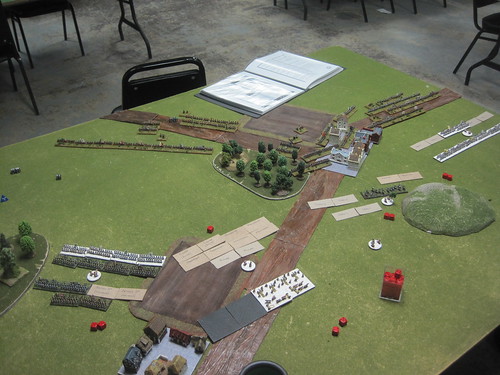
Our two lines closed to musket range, and a rolling fire developed across the line.

It was at this point that I encountered the other end of the command dilemma. The musketry duel, surprisingly, went my way. Although the Brits have advantages firing, Marke couldn't roll to save his life, and we came away about even, with both of us losing a unit, and having one recoil. He actually took more damage overall, and I was all set to press home an assault. At which point, my sub-commander (the one with a -2 personality modifier on his activation roll), promptly sat on his derriere for three consecutive pulses.

Rather than producing a decisive assault (and boy, were those rosbif begging for it), the fight turned into a running musket duel. I later realized that if I'd moved my overall commander into b2b with Le Marquis de Slowpoke I could have compelled the Force to advance, but at the time, it was teeth grindingly frustrating. My dragoons had a lovely view of the fire-fight, however.
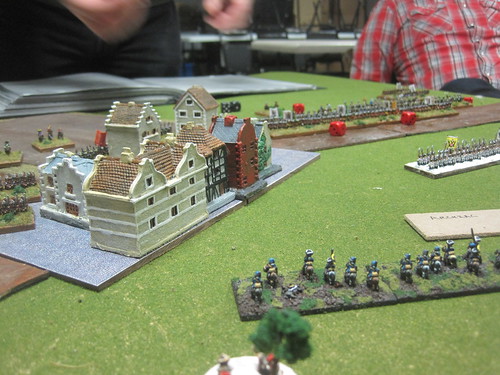
On the left, my troops had finally slogged their way across the table to contact. The attack was piecemeal, however. It's difficult to manouvre large formations in line, and the inability of formed infantry to interpenetrate meant my units "stacked up". While some attacks, notably from the cavalry, went home, they were largely ineffective, and that flank rapidly turned into something of a melee.
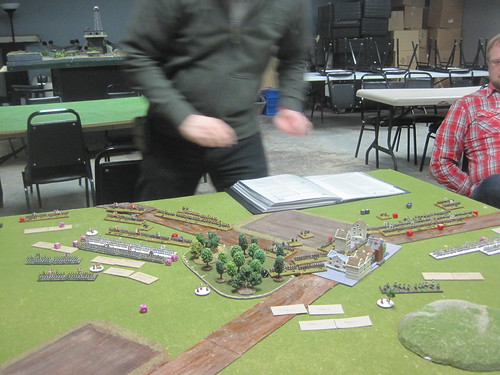
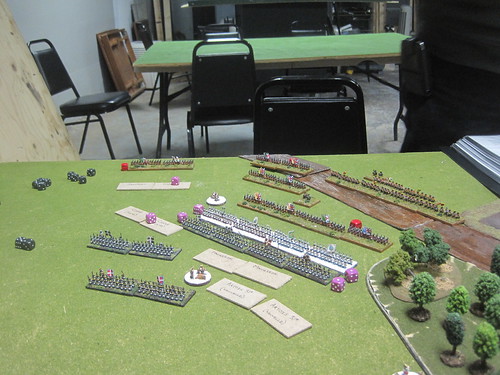
We had to call the game for time at that point.
This was, in every respect, a learning game. We probably spent more time looking things up than actually moving figures. On the other hand, by the end of the game, we had core mechanics down, and were increasingly confident in terms of "what we should have done". I'd love to get another game in soon to see if I can apply what I learned.
My overall impression of the game is that it's quite good, and clearly falls into the historical (as opposed to history-flavoured) category. I've enjoyed any of Sam's games I've played, and M&R is no exception. The game mechanics aren't intrusive, but do tend to produce outcomes I associate with the period. Cavalry are important, but can't be used as shock troops to break prepared infantry. Linear formations are critical for combat (unit are VERY vulnerable if caught strung out on the march), but slow and unwieldy. Command is unpredictable. While one can "direct attention" to gain more influence over parts of the battle, sub-commanders have minds of their own and don't always act the way you want them to. Combat is costly, even the winners get chewed up.
Overall, I think the command mechanics are what define the game. The command dice mechanic is brilliant. There's never enough to go around, but too much focus on one part of the battle means you risk not being able to intervene at a later, other event. For example, at a critical juncture in the fight on my right, I desperately needed a re-roll on one of my combat dice. Unfortunately, it was the third pulse of the game, and I had already expended them trying to get my commands moving earlier in the turn. Mon Dieu!
Things I learned. The French are big, slow, and tend to be hard to control. I think a larger number of smaller forces is a necessary first step. I need to keep more of my infantry in March order, and use my cavalry to screen them. Being big, the French can lose units without worrying too much. I'm better off deploying a forward screen, and doing what I can to keep the rest of the army in reserve until I know where my opponent is going to commit. I was reading over the "Army Tips" Sam posted on his website, and the first thing that caught my eye was a comment that it's hard to attack with the French. Absolutely (ha!). They just don't have the speed and concentration of force to organize coordinated attacks. The French are a tar-baby army, and I need to learn to play them as such.
Next week I've managed to book a game of 15mm Impetus, so should be able to get some good eye candy shots with my Antigonids. In the meantime, here's some pictures of the 25/28mm game that JJM and Jack1080 were playing behind us. Romans vs. Romans. I understand the Romans won.

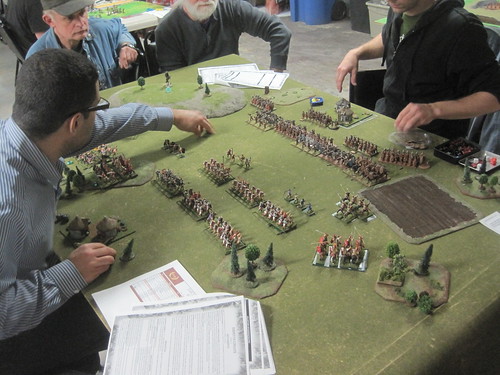
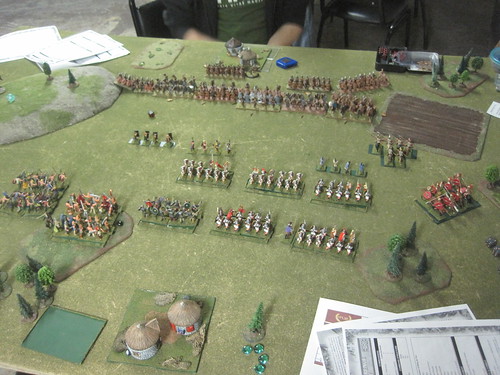
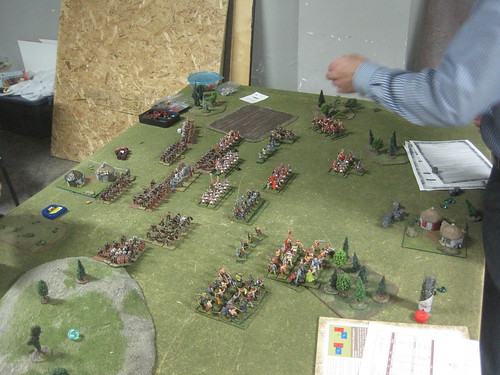
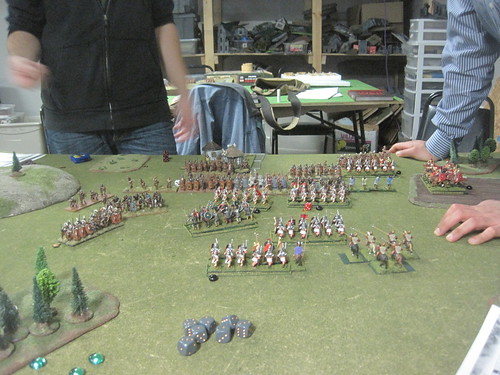
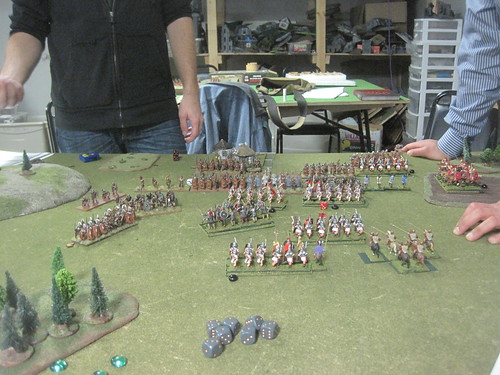
FMB
Oh yeah. Might and Reason is a really good game. I used to play it quite often, with British and Russian troops. Next tie, try against Prussians... I hope then you like scary movies ;P
ReplyDelete